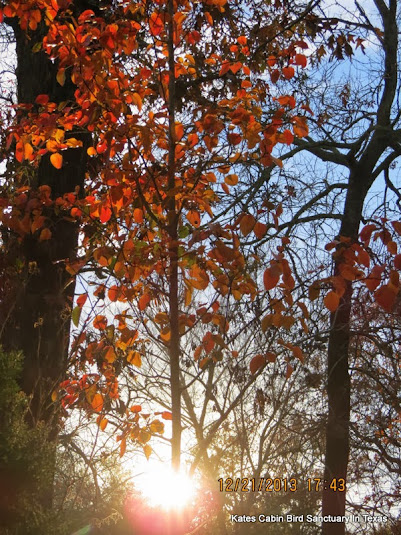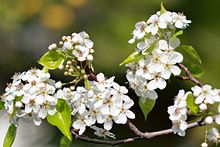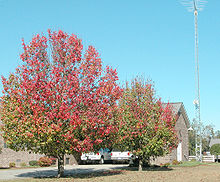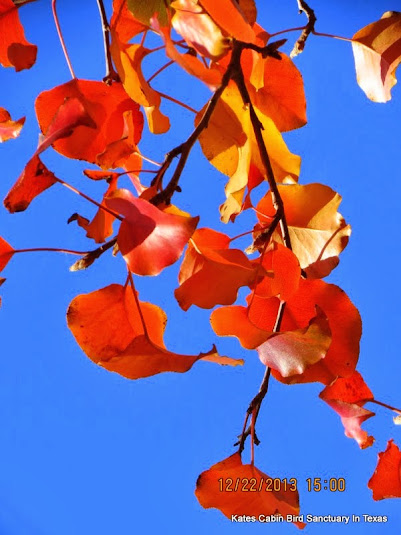
Hi Everybody:
Well, thank goodness this location missed out on the tornadoes and high winds of this last coldfront. The cold air did arrive and I have the heater on! After the front slipped in, the sun broke thru in the afternoon revealing flaming leaves on the flowering pear trees. The cloud cover returned this morning and again it was cold and grey. This afternoon the sun popped out, so I got a bonus day on these beautiful leaves to share with You at the links below. Also shared is info from Wikipedia on the Callery Pear Trees. Enjoy!!








link to photostudy:
https://plus.google.com/u/0/photos/117645114459863049265/albums/5960228792956795841


https://en.wikipedia.org/wiki/Pyrus_calleryana
Pyrus calleryana
From Wikipedia, the free encyclopedia
Pyrus calleryana, the Callery pear, is a species of pear native to China and Vietnam,[2] in the family Rosaceae. It is a deciduous tree growing to 15 to 20 m (49 to 66 ft) tall, often with a conic to rounded crown. The leaves are oval, 4 to 7 cm (1.6 to 2.8 in) long, glossy dark green above, and slightly paler below. The white, five-petaled flowers are about 2 to 3 cm (0.79 to 1.2 in) in diameter. They are produced abundantly in early spring, before the leaves expand fully.
The fruits of the Callery pear are small (less than one cm in diameter), and hard, almost woody, until softened by frost, after which they are readily taken by birds, which disperse the seeds in their droppings. In summer, the foliage is dark green and very smooth, and in autumn the leaves commonly turn brilliant colors, ranging from yellow and orange to more commonly red, pink, purple, and bronze. Sometimes, several of these fall colors may be present on an individual leaf. However, since the color often develops very late in fall, the leaves may be killed by a hard frost before full color can develop.
Callery pears are remarkably resistant to sicknesses or blight; they are more often killed by storms or high winds than by sickness. Some cultivars, such as 'Bradford', are particularly susceptible to storm damage.
The species is named after the Italian-French sinologue Joseph-Marie Callery (1810–1862) who sent specimens of the tree to Europe from China.[3][4]
| Pyrus calleryana | |
|---|---|
 | |
| Pyrus calleryana[1] | |
 | |
| Callery pear blossoms | |
| Scientific classification | |
| Kingdom: | Plantae |
| (unranked): | Angiosperms |
| (unranked): | Eudicots |
| (unranked): | Rosids |
| Order: | Rosales |
| Family: | Rosaceae |
| Genus: | Pyrus |
| Species: | P. calleryana |
| Binomial name | |
| Pyrus calleryana Decne. | |
Cultivation
In much of North America, cultivars of P. calleryana are so widely planted as ornamental trees that they have become an ubiquity in many urban and suburban communities. It is tolerant of a variety of soil types, drainage levels, and soil acidity. Its crown shape varies from ovate to elliptical. The symmetry of several cultivars lends to their use in somewhat formal settings, such as city streets, shopping centers, office parks, and industrial parks. Its dense clusters of white blossoms are conspicuous in early spring along the boulevards of many eastern United States towns. At the latitude of Pittsburgh, Pennsylvania, the trees often remain green until mid-November, and in warm autumns, the colors are often a brilliant end to the fall color season, although in a cold year they may get frozen off before coloring. In the South, Callery pears tend to be among the more reliable coloring trees.
Several cultivars of Callery pear are offered commercially, including 'Aristocrat', 'Autumn Blaze', 'Bradford' (the commonly planted Bradford pear), 'Capital', 'Chanticleer' (also known as 'Cleveland Select'), 'New Bradford', 'Redspire', and 'Whitehouse'.
The neat, dense upward growth of 'Bradford' — which made it desirable in cramped urban spaces — also results in a multitude of narrow, weak forks, unless corrected by selectivepruning at an early stage. These weak crotches make the Bradford Pear very susceptible to storm damage where snowfall is heavy or when ice storms occur, or during the high winds of severe thunderstorms. Because of this, and the resulting relatively short life span(typically less than 25 years), many groups have discouraged further planting of 'Bradford' itself in favor of other, stronger Callery pear cultivars (such other as 'Cleveland Select'), as well as increased use of locally native ornamental tree species.
Cultivated Callery pears in flower

Uses[edit]
Pear wood (of any species) has one of the finest textures of the fruitwoods. It is prized for making woodwind instruments, and pear veneer is used in fine furniture.[5]
Callery pear has been used as rootstock for grafting such pear cultivars as Comice, Bosc, or Seckel, and especially for nashi pear. Pyrus calleryana was first introduced into the United States (in 1909 and 1916) for agricultural experimentation, pre-dating the recognition of the potential value appreciation of the species as an ornamental plant in the 1950s.[2]






link to photostudy:
https://plus.google.com/u/0/photos/117645114459863049265/albums/5960397898660098481

...this is brendasue signing off from Rainbow Creek. See You next time! Joy to the World!!

O+O

No comments:
Post a Comment
Hi Everybody! Please say hello and follow so I know you are here! Due to the inconsideration of people trying to put commercials on my blog comment area, I have restricted use of anonymous posts. Sorry that some hurt all.
My public email is katescabin@gmail.com No spammers or trolls